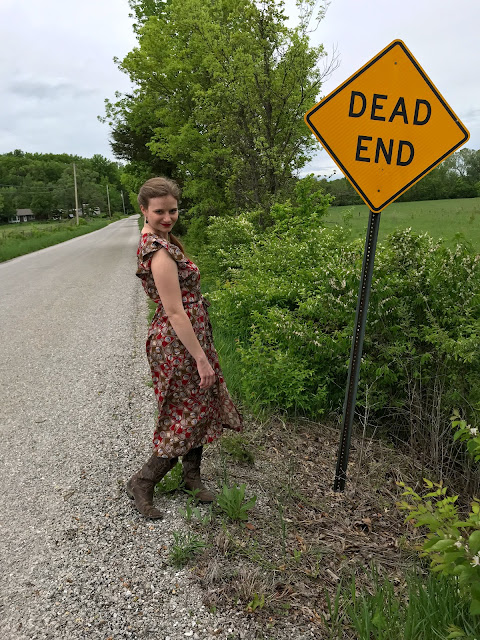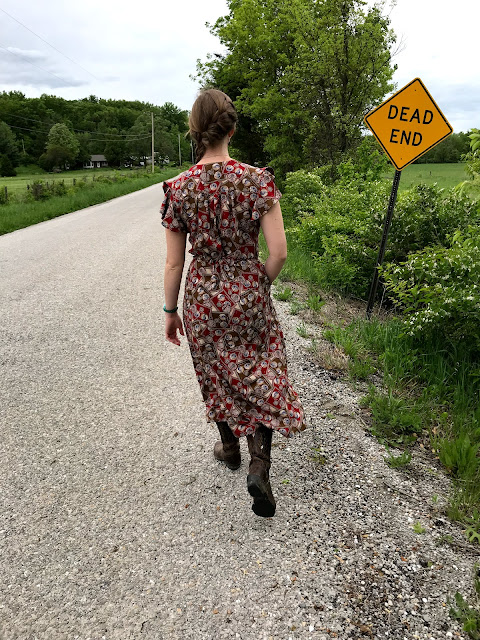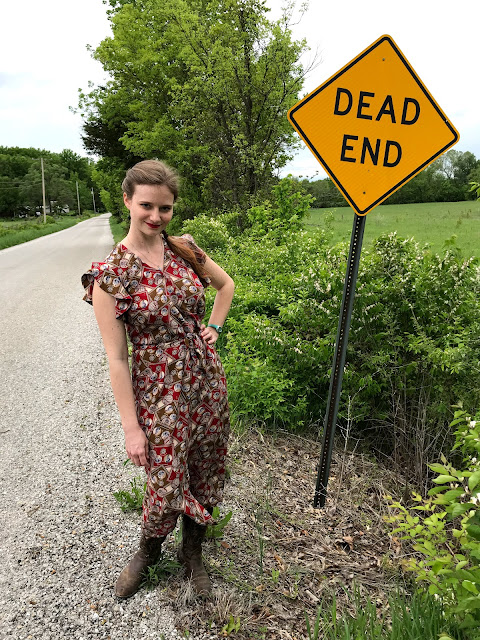As I was making the gown, it didn't take me long to develop an appreciation for the beauty of the long flowing back pleats on this style of gown. And wearing the gown? That threw me head over heels in love with this style. There is something magical about walking with the back of your gown billowing out elegantly behind you.
Thus, my reservations on the shape and style of this type of gown disappeared as soon as I started making it. I only had one worry left. How would I be trimming the thing?? What really finishes off the look of a saque is self-fabric trimmings, pleated, gathered, or puffed, and stitched down the front of the gown. The process of trimming the gown sounded long, tedious, and rather exhausting to me. I appreciate the look of all the trimmings on extant gowns, and on other people's re-creations, but I was rather dreading trimming my own gown. Yet, I didn't want to skimp, so my Robe a la Francaise would be trimmed beautifully. I just had to decide what shape this trim would take. I visited the wild lands of Pinterest for inspiration.
 |
| 1760 Gown and Petticoat (Robe à la française) | LACMA Collections |
I found a picture of this 1760's linen (embroidered with wool) Robe a la Francaise and fell in love with the trimmings on it - relatively simple pleated trim with the edges trimmed (or bound?) in some sort of green material. These were the trimmings I wanted to recreate for my gown, so I went to Hobby Lobby and bought 6 rolls of green ribbon while ribbon was on sale 50% off.
I bought both 5/8" and 1 1/2" wide green grosgrain ribbon. The narrower ribbon would be used to bind the edges of all the self fabric trim, and the wider ribbon would be used to bedeck the stomacher in bows. Both ribbons are, of course, polyester, not silk, but as historical accuracy concerns had already been thrown out the window, that was fine.
After cutting out my gown, I didn't have a whole lot of fabric left over to use for trim. There was one large-ish piece of material left over. It was the full width of the fabric and just over a yard long, and it would need to be saved to make the petticoat to go with the gown. This meant my trim would have to be made from fabric scraps, not leftover yardage. Thankfully, I had two large scraps, about one yard long and 12" (ish) wide. Each of these was cut into three narrower strips, and the six resulting strips were pieced together end to end, giving me plenty of material for my trim.
I bound the raw edges of the fabric strips in the green ribbon, then began pleating the trim onto my gown. This was the one portion of making this dress that took the most time.
I referenced the pleat pattern of the trim on my inspiration gown, then spent a couple evenings in front of the TV pleating, pleating, and pleating, I used just about every straight pin in the house in the process. My long, pieced together, strip of material, turned out to be just the right length for the trim.
Finally, I machine stitched the trim to my gown, all along either side of the front opening and around the back neckline.
With the front trimmed, the second place the gown itself needed trim was the sleeves. The sleeves needed ruffles - lovely scalloped, self-fabric, ruffles similar to those seen on the extant gown I was using for inspiration. These sleeve ruffles are probably my favorite feature of 18th century gowns.
 |
| Woman's Gown and Petticoat (Robe à la française) | LACMA Collections |
I cut out the sleeve ruffles using the pattern piece included with the Simplicity pattern I was using as my template. However, I made my scallops much less dense than those on the Simplicity dress. I would be binding my sleeve ruffles with green ribbon to match my pleated trim, so my scallops couldn't be too scalloped, or binding would be impossible.
Binding scallops sounded like a nearly impossible task, so I was surprised and thrilled when it actually went very well! Once the ruffles were bound in ribbon, I pleated them onto the sleeves and machine sewed them into place.
Ruffles on, there was one last thing the gown needed - lace sleeve ruffles! (Also called engageantes).
I looked through my lace stash to find something suitable for these wonderful ruffles. I came up with several possibilities. As my engageantes were to be made quickly the morning of the picnic, by sewing machine, I opted to use the lace I was least attached to from my suitable options and leave the lovely vintage pieces in my stash for future projects I would be able to spend a bit more time on.
As the fabric sleeve ruffles were asymmetric, longer at the back than the front, my lace ruffles needed to be asymmetric as well. To make the back longer than the front I cut out a half circle of netting for the back of each sleeve ruffle, and attached the pre-gathered lace for the back of the ruffle to that with a zig-zag stitch.
I pleated the lace and netting onto a circle of cotton ribbon, cut to be the same circumference as the bottom of my sleeves. I zig-zag stitched the lace to the ribbon, and the engageantes were ready to go on my gown.
Out of time to do anything else, as I was needing to leave for the picnic that minute and still not dressed, I safety pinned the ruffles into the sleeves, and threw the gown on.
From the outside there is no hint of the safety pins and the sleeves are marvelously ruffly!
The ruffles and trim made my gown look finished - and much less tedious to make than I'd expected.
Off to the picnic I went, with absolutely no regrets about the style of dress I made, or how I chose to trim it!


















































